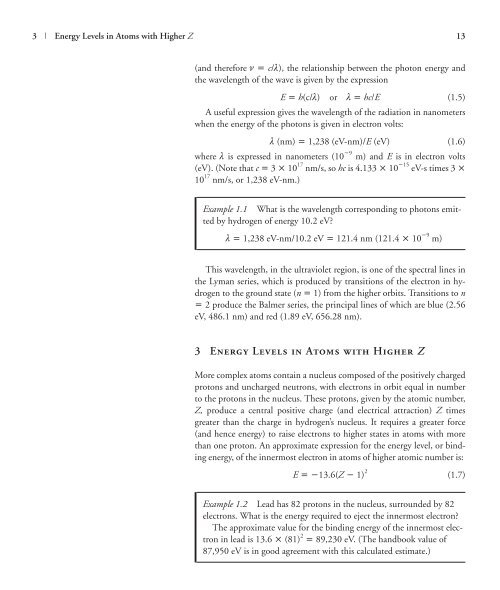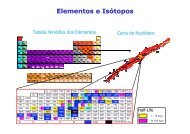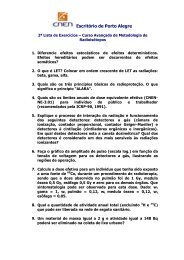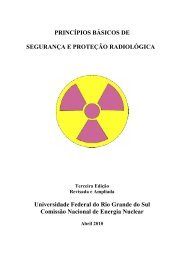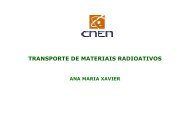- Page 1: RADIATION PROTECTION
- Page 4 and 5: Copyright © 1972, 1981, 1990, 2002
- Page 7 and 8: Preface This manual explains the pr
- Page 9 and 10: Preface ix information, primarily f
- Page 11: Preface xi cluded Internet addresse
- Page 14 and 15: xiv contents 5 The Stopping Power E
- Page 16 and 17: xvi contents 25.4 Radiography of th
- Page 18 and 19: xviii contents 8 Radiation Doses in
- Page 20 and 21: xx contents 8 Posting of Areas 349
- Page 22 and 23: xxii contents 5 Sources Producing P
- Page 24 and 25: xxiv contents 13 Exposures to Patie
- Page 26 and 27: 2 Historical Prologue This speck of
- Page 28 and 29: 4 Historical Prologue P.1 Evolution
- Page 30 and 31: 6 Historical Prologue P.2 Compositi
- Page 32 and 33: 8 Historical Prologue ating their c
- Page 34 and 35: 10 ONE | Energy—The Unifying Conc
- Page 38 and 39: 14 ONE | Energy—The Unifying Conc
- Page 40 and 41: 16 ONE | Energy—The Unifying Conc
- Page 42 and 43: PART TWO Principles of Protection a
- Page 44 and 45: 20 TWO | Principles of Protection a
- Page 46 and 47: 22 TWO | Principles of Protection a
- Page 48 and 49: 24 TWO | Principles of Protection a
- Page 50 and 51: 26 TWO | Principles of Protection a
- Page 52 and 53: 28 TWO | Principles of Protection a
- Page 54 and 55: 30 TWO | Principles of Protection a
- Page 56 and 57: 32 TWO | Principles of Protection a
- Page 58 and 59: 34 TWO | Principles of Protection a
- Page 60 and 61: 36 TWO | Principles of Protection a
- Page 62 and 63: 38 TWO | Principles of Protection a
- Page 64 and 65: 40 TWO | Principles of Protection a
- Page 66 and 67: 42 TWO | Principles of Protection a
- Page 68 and 69: 44 TWO | Principles of Protection a
- Page 70 and 71: 46 TWO | Principles of Protection a
- Page 72 and 73: 48 TWO | Principles of Protection a
- Page 74 and 75: 50 TWO | Principles of Protection a
- Page 76 and 77: 52 TWO | Principles of Protection a
- Page 78 and 79: 54 TWO | Principles of Protection a
- Page 80 and 81: 56 TWO | Principles of Protection a
- Page 82 and 83: 58 TWO | Principles of Protection a
- Page 84 and 85: 60 TWO | Principles of Protection a
- Page 86 and 87:
62 TWO | Principles of Protection a
- Page 88 and 89:
64 TWO | Principles of Protection a
- Page 90 and 91:
66 TWO | Principles of Protection a
- Page 92 and 93:
68 TWO | Principles of Protection a
- Page 94 and 95:
70 TWO | Principles of Protection a
- Page 96 and 97:
72 TWO | Principles of Protection a
- Page 98 and 99:
74 TWO | Principles of Protection a
- Page 100 and 101:
76 TWO | Principles of Protection a
- Page 102 and 103:
78 TWO | Principles of Protection a
- Page 104 and 105:
80 TWO | Principles of Protection a
- Page 106 and 107:
82 TWO | Principles of Protection a
- Page 108 and 109:
84 TWO | Principles of Protection a
- Page 110 and 111:
86 TWO | Principles of Protection a
- Page 112 and 113:
88 TWO | Principles of Protection a
- Page 114 and 115:
90 TWO | Principles of Protection a
- Page 116 and 117:
92 TWO | Principles of Protection a
- Page 118 and 119:
94 TWO | Principles of Protection a
- Page 120 and 121:
96 TWO | Principles of Protection a
- Page 122 and 123:
98 TWO | Principles of Protection a
- Page 124 and 125:
100 TWO | Principles of Protection
- Page 126 and 127:
102 TWO | Principles of Protection
- Page 128 and 129:
104 TWO | Principles of Protection
- Page 130 and 131:
106 TWO | Principles of Protection
- Page 132 and 133:
108 TWO | Principles of Protection
- Page 134 and 135:
110 TWO | Principles of Protection
- Page 136 and 137:
112 TWO | Principles of Protection
- Page 138 and 139:
114 TWO | Principles of Protection
- Page 140 and 141:
116 TWO | Principles of Protection
- Page 142 and 143:
118 TWO | Principles of Protection
- Page 144 and 145:
120 TWO | Principles of Protection
- Page 146 and 147:
122 TWO | Principles of Protection
- Page 148 and 149:
124 TWO | Principles of Protection
- Page 150 and 151:
126 TWO | Principles of Protection
- Page 152 and 153:
128 TWO | Principles of Protection
- Page 154 and 155:
130 TWO | Principles of Protection
- Page 156 and 157:
132 TWO | Principles of Protection
- Page 158 and 159:
134 TWO | Principles of Protection
- Page 160 and 161:
136 TWO | Principles of Protection
- Page 162 and 163:
138 TWO | Principles of Protection
- Page 164 and 165:
140 TWO | Principles of Protection
- Page 166 and 167:
142 TWO | Principles of Protection
- Page 168 and 169:
144 TWO | Principles of Protection
- Page 170 and 171:
146 TWO | Principles of Protection
- Page 172 and 173:
148 TWO | Principles of Protection
- Page 174 and 175:
150 TWO | Principles of Protection
- Page 176 and 177:
152 TWO | Principles of Protection
- Page 178 and 179:
154 TWO | Principles of Protection
- Page 180 and 181:
156 TWO | Principles of Protection
- Page 182 and 183:
158 TWO | Principles of Protection
- Page 184 and 185:
160 TWO | Principles of Protection
- Page 186 and 187:
162 TWO | Principles of Protection
- Page 188 and 189:
164 TWO | Principles of Protection
- Page 190 and 191:
166 TWO | Principles of Protection
- Page 192 and 193:
168 THREE | Radiation Dose Calculat
- Page 194 and 195:
170 THREE | Radiation Dose Calculat
- Page 196 and 197:
172 THREE | Radiation Dose Calculat
- Page 198 and 199:
174 THREE | Radiation Dose Calculat
- Page 200 and 201:
176 THREE | Radiation Dose Calculat
- Page 202 and 203:
178 THREE | Radiation Dose Calculat
- Page 204 and 205:
180 THREE | Radiation Dose Calculat
- Page 206 and 207:
182 THREE | Radiation Dose Calculat
- Page 208 and 209:
184 THREE | Radiation Dose Calculat
- Page 210 and 211:
186 THREE | Radiation Dose Calculat
- Page 212 and 213:
188 THREE | Radiation Dose Calculat
- Page 214 and 215:
190 THREE | Radiation Dose Calculat
- Page 216 and 217:
192 THREE | Radiation Dose Calculat
- Page 218 and 219:
194 THREE | Radiation Dose Calculat
- Page 220 and 221:
196 THREE | Radiation Dose Calculat
- Page 222 and 223:
198 THREE | Radiation Dose Calculat
- Page 224 and 225:
200 THREE | Radiation Dose Calculat
- Page 226 and 227:
202 THREE | Radiation Dose Calculat
- Page 228 and 229:
204 THREE | Radiation Dose Calculat
- Page 230 and 231:
206 THREE | Radiation Dose Calculat
- Page 232 and 233:
208 THREE | Radiation Dose Calculat
- Page 234 and 235:
210 THREE | Radiation Dose Calculat
- Page 236 and 237:
212 THREE | Radiation Dose Calculat
- Page 238 and 239:
214 THREE | Radiation Dose Calculat
- Page 240 and 241:
216 THREE | Radiation Dose Calculat
- Page 242 and 243:
218 THREE | Radiation Dose Calculat
- Page 244 and 245:
220 THREE | Radiation Dose Calculat
- Page 246 and 247:
222 THREE | Radiation Dose Calculat
- Page 248 and 249:
224 THREE | Radiation Dose Calculat
- Page 250 and 251:
226 THREE | Radiation Dose Calculat
- Page 252 and 253:
228 THREE | Radiation Dose Calculat
- Page 254 and 255:
230 THREE | Radiation Dose Calculat
- Page 256 and 257:
232 THREE | Radiation Dose Calculat
- Page 258 and 259:
234 THREE | Radiation Dose Calculat
- Page 260 and 261:
236 THREE | Radiation Dose Calculat
- Page 262 and 263:
238 THREE | Radiation Dose Calculat
- Page 264 and 265:
240 THREE | Radiation Dose Calculat
- Page 266 and 267:
242 THREE | Radiation Dose Calculat
- Page 268 and 269:
244 THREE | Radiation Dose Calculat
- Page 270 and 271:
246 THREE | Radiation Dose Calculat
- Page 272 and 273:
248 THREE | Radiation Dose Calculat
- Page 274 and 275:
PART FOUR Radiation Measurements Th
- Page 276 and 277:
252 FOUR | Radiation Measurements 1
- Page 278 and 279:
254 FOUR | Radiation Measurements i
- Page 280 and 281:
256 FOUR | Radiation Measurements p
- Page 282 and 283:
258 FOUR | Radiation Measurements d
- Page 284 and 285:
260 FOUR | Radiation Measurements 4
- Page 286 and 287:
262 FOUR | Radiation Measurements 1
- Page 288 and 289:
264 FOUR | Radiation Measurements e
- Page 290 and 291:
266 FOUR | Radiation Measurements e
- Page 292 and 293:
Net counts (background subtracted)
- Page 294 and 295:
270 FOUR | Radiation Measurements 2
- Page 296 and 297:
272 FOUR | Radiation Measurements 4
- Page 298 and 299:
274 FOUR | Radiation Measurements 4
- Page 300 and 301:
276 FOUR | Radiation Measurements 2
- Page 302 and 303:
278 FOUR | Radiation Measurements 4
- Page 304 and 305:
280 FOUR | Radiation Measurements b
- Page 306 and 307:
282 FOUR | Radiation Measurements C
- Page 308 and 309:
284 FOUR | Radiation Measurements a
- Page 310 and 311:
286 FOUR | Radiation Measurements T
- Page 312 and 313:
288 FOUR | Radiation Measurements c
- Page 314 and 315:
290 FOUR | Radiation Measurements S
- Page 316 and 317:
292 FOUR | Radiation Measurements p
- Page 318 and 319:
294 FOUR | Radiation Measurements r
- Page 320 and 321:
296 FOUR | Radiation Measurements s
- Page 322 and 323:
298 FOUR | Radiation Measurements T
- Page 324 and 325:
300 FOUR | Radiation Measurements m
- Page 326 and 327:
302 FOUR | Radiation Measurements t
- Page 328 and 329:
304 FOUR | Radiation Measurements 4
- Page 330 and 331:
306 FOUR | Radiation Measurements s
- Page 332 and 333:
308 FOUR | Radiation Measurements a
- Page 334 and 335:
310 FOUR | Radiation Measurements T
- Page 336 and 337:
312 FOUR | Radiation Measurements 6
- Page 338 and 339:
314 FOUR | Radiation Measurements E
- Page 340 and 341:
316 FOUR | Radiation Measurements w
- Page 342 and 343:
318 FOUR | Radiation Measurements 4
- Page 344 and 345:
320 FOUR | Radiation Measurements r
- Page 346 and 347:
PART FIVE Practical Aspects of the
- Page 348 and 349:
324 FIVE | Practical Aspects of the
- Page 350 and 351:
326 FIVE | Practical Aspects of the
- Page 352 and 353:
328 FIVE | Practical Aspects of the
- Page 354 and 355:
330 FIVE | Practical Aspects of the
- Page 356 and 357:
332 FIVE | Practical Aspects of the
- Page 358 and 359:
334 FIVE | Practical Aspects of the
- Page 360 and 361:
336 FIVE | Practical Aspects of the
- Page 362 and 363:
338 FIVE | Practical Aspects of the
- Page 364 and 365:
340 FIVE | Practical Aspects of the
- Page 366 and 367:
342 FIVE | Practical Aspects of the
- Page 368 and 369:
344 FIVE | Practical Aspects of the
- Page 370 and 371:
346 FIVE | Practical Aspects of the
- Page 372 and 373:
348 FIVE | Practical Aspects of the
- Page 374 and 375:
350 FIVE | Practical Aspects of the
- Page 376 and 377:
352 FIVE | Practical Aspects of the
- Page 378 and 379:
354 FIVE | Practical Aspects of the
- Page 380 and 381:
356 FIVE | Practical Aspects of the
- Page 382 and 383:
358 FIVE | Practical Aspects of the
- Page 384 and 385:
360 FIVE | Practical Aspects of the
- Page 386 and 387:
362 FIVE | Practical Aspects of the
- Page 388 and 389:
364 FIVE | Practical Aspects of the
- Page 390 and 391:
366 FIVE | Practical Aspects of the
- Page 392 and 393:
368 FIVE | Practical Aspects of the
- Page 394 and 395:
370 FIVE | Practical Aspects of the
- Page 396 and 397:
372 FIVE | Practical Aspects of the
- Page 398 and 399:
374 FIVE | Practical Aspects of the
- Page 400 and 401:
376 FIVE | Practical Aspects of the
- Page 402 and 403:
378 FIVE | Practical Aspects of the
- Page 404 and 405:
380 FIVE | Practical Aspects of the
- Page 406 and 407:
382 FIVE | Practical Aspects of the
- Page 408 and 409:
384 FIVE | Practical Aspects of the
- Page 410 and 411:
386 FIVE | Practical Aspects of the
- Page 412 and 413:
388 FIVE | Practical Aspects of the
- Page 414 and 415:
390 FIVE | Practical Aspects of the
- Page 416 and 417:
392 FIVE | Practical Aspects of the
- Page 418 and 419:
394 FIVE | Practical Aspects of the
- Page 420 and 421:
396 FIVE | Practical Aspects of the
- Page 422 and 423:
398 FIVE | Practical Aspects of the
- Page 424 and 425:
400 FIVE | Practical Aspects of the
- Page 426 and 427:
402 FIVE | Practical Aspects of the
- Page 428 and 429:
404 FIVE | Practical Aspects of the
- Page 430 and 431:
406 SIX | Ionizing Radiation and Pu
- Page 432 and 433:
408 SIX | Ionizing Radiation and Pu
- Page 434 and 435:
410 SIX | Ionizing Radiation and Pu
- Page 436 and 437:
412 SIX | Ionizing Radiation and Pu
- Page 438 and 439:
414 SIX | Ionizing Radiation and Pu
- Page 440 and 441:
416 SIX | Ionizing Radiation and Pu
- Page 442 and 443:
418 SIX | Ionizing Radiation and Pu
- Page 444 and 445:
420 SIX | Ionizing Radiation and Pu
- Page 446 and 447:
422 SIX | Ionizing Radiation and Pu
- Page 448 and 449:
424 SIX | Ionizing Radiation and Pu
- Page 450 and 451:
426 SIX | Ionizing Radiation and Pu
- Page 452 and 453:
428 SIX | Ionizing Radiation and Pu
- Page 454 and 455:
430 SIX | Ionizing Radiation and Pu
- Page 456 and 457:
432 SIX | Ionizing Radiation and Pu
- Page 458 and 459:
434 SIX | Ionizing Radiation and Pu
- Page 460 and 461:
436 SIX | Ionizing Radiation and Pu
- Page 462 and 463:
438 SIX | Ionizing Radiation and Pu
- Page 464 and 465:
440 SIX | Ionizing Radiation and Pu
- Page 466 and 467:
442 SIX | Ionizing Radiation and Pu
- Page 468 and 469:
444 SIX | Ionizing Radiation and Pu
- Page 470 and 471:
446 SIX | Ionizing Radiation and Pu
- Page 472 and 473:
448 SIX | Ionizing Radiation and Pu
- Page 474 and 475:
450 SIX | Ionizing Radiation and Pu
- Page 476 and 477:
452 SIX | Ionizing Radiation and Pu
- Page 478 and 479:
454 SIX | Ionizing Radiation and Pu
- Page 480 and 481:
456 SIX | Ionizing Radiation and Pu
- Page 482 and 483:
458 SIX | Ionizing Radiation and Pu
- Page 484 and 485:
460 Table 6.12 Activity in the envi
- Page 486 and 487:
462 SIX | Ionizing Radiation and Pu
- Page 488 and 489:
464 SIX | Ionizing Radiation and Pu
- Page 490 and 491:
466 SIX | Ionizing Radiation and Pu
- Page 492 and 493:
468 SIX | Ionizing Radiation and Pu
- Page 494 and 495:
470 SIX | Ionizing Radiation and Pu
- Page 496 and 497:
472 SIX | Ionizing Radiation and Pu
- Page 498 and 499:
474 SIX | Ionizing Radiation and Pu
- Page 500 and 501:
476 SIX | Ionizing Radiation and Pu
- Page 502 and 503:
478 SIX | Ionizing Radiation and Pu
- Page 504 and 505:
480 SIX | Ionizing Radiation and Pu
- Page 506 and 507:
482 SIX | Ionizing Radiation and Pu
- Page 508 and 509:
484 SIX | Ionizing Radiation and Pu
- Page 510 and 511:
486 SIX | Ionizing Radiation and Pu
- Page 512 and 513:
488 SIX | Ionizing Radiation and Pu
- Page 514 and 515:
490 SIX | Ionizing Radiation and Pu
- Page 516 and 517:
492 SIX | Ionizing Radiation and Pu
- Page 518 and 519:
494 SIX | Ionizing Radiation and Pu
- Page 520 and 521:
496 SIX | Ionizing Radiation and Pu
- Page 522 and 523:
498 SIX | Ionizing Radiation and Pu
- Page 524 and 525:
500 SIX | Ionizing Radiation and Pu
- Page 526 and 527:
502 SIX | Ionizing Radiation and Pu
- Page 528 and 529:
504 SIX | Ionizing Radiation and Pu
- Page 530 and 531:
506 SIX | Ionizing Radiation and Pu
- Page 532 and 533:
508 SIX | Ionizing Radiation and Pu
- Page 534 and 535:
510 SIX | Ionizing Radiation and Pu
- Page 536 and 537:
PART SEVEN Exposure to Nonionizing
- Page 538 and 539:
514 SEVEN | Exposure to Nonionizing
- Page 540 and 541:
516 SEVEN | Exposure to Nonionizing
- Page 542 and 543:
518 SEVEN | Exposure to Nonionizing
- Page 544 and 545:
520 SEVEN | Exposure to Nonionizing
- Page 546 and 547:
522 SEVEN | Exposure to Nonionizing
- Page 548 and 549:
524 SEVEN | Exposure to Nonionizing
- Page 550 and 551:
526 SEVEN | Exposure to Nonionizing
- Page 552 and 553:
528 SEVEN | Exposure to Nonionizing
- Page 554 and 555:
530 SEVEN | Exposure to Nonionizing
- Page 556 and 557:
532 SEVEN | Exposure to Nonionizing
- Page 558 and 559:
534 SEVEN | Exposure to Nonionizing
- Page 560 and 561:
536 SEVEN | Exposure to Nonionizing
- Page 562 and 563:
538 SEVEN | Exposure to Nonionizing
- Page 564 and 565:
540 SEVEN | Exposure to Nonionizing
- Page 566 and 567:
542 SEVEN | Exposure to Nonionizing
- Page 568 and 569:
544 SEVEN | Exposure to Nonionizing
- Page 570 and 571:
546 SEVEN | Exposure to Nonionizing
- Page 572 and 573:
548 SEVEN | Exposure to Nonionizing
- Page 574 and 575:
550 SEVEN | Exposure to Nonionizing
- Page 576 and 577:
552 SEVEN | Exposure to Nonionizing
- Page 578 and 579:
554 SEVEN | Exposure to Nonionizing
- Page 580 and 581:
556 SEVEN | Exposure to Nonionizing
- Page 582 and 583:
558 SEVEN | Exposure to Nonionizing
- Page 584 and 585:
560 SEVEN | Exposure to Nonionizing
- Page 586 and 587:
562 SEVEN | Exposure to Nonionizing
- Page 588 and 589:
564 SEVEN | Exposure to Nonionizing
- Page 590 and 591:
PART EIGHT Current Issues in Radiat
- Page 592 and 593:
568 EIGHT | Current Issues in Radia
- Page 594 and 595:
570 EIGHT | Current Issues in Radia
- Page 596 and 597:
572 EIGHT | Current Issues in Radia
- Page 598 and 599:
574 EIGHT | Current Issues in Radia
- Page 600 and 601:
576 EIGHT | Current Issues in Radia
- Page 602 and 603:
578 EIGHT | Current Issues in Radia
- Page 604 and 605:
580 EIGHT | Current Issues in Radia
- Page 607 and 608:
APPENDIX I Problems A few practice
- Page 609 and 610:
Problems 585 A patient is to be giv
- Page 611 and 612:
Problems 587 The standard solution
- Page 613 and 614:
Problems 589 and the attenuation fa
- Page 615 and 616:
Data on Selected Radionuclides 591
- Page 617 and 618:
Data on Selected Radionuclides 593
- Page 619 and 620:
Some Constants and Conversion Facto
- Page 621 and 622:
Selected Bibliography basic texts a
- Page 623 and 624:
Selected Bibliography 599 such stan
- Page 625 and 626:
References AAPM. 2001. Reference Va
- Page 627 and 628:
References 603 Hazardous Electromag
- Page 629 and 630:
References 605 ogists 1998 Internat
- Page 631 and 632:
References 607 Brown, B. H., et al.
- Page 633 and 634:
References 609 Marshallese Populati
- Page 635 and 636:
References 611 Eisenbud, M. 1963. E
- Page 637 and 638:
References 613 1977. Environmental
- Page 639 and 640:
References 615 Chronic Diseases. Na
- Page 641 and 642:
References 617 treated with x-rays
- Page 643 and 644:
References 619 tional Laboratory Re
- Page 645 and 646:
References 621 ——— 1985b. Sta
- Page 647 and 648:
References 623 ISS. 1978. The Milit
- Page 649 and 650:
References 625 Kling, T. F., Jr., e
- Page 651 and 652:
References 627 ogy: Diagnosis—Ima
- Page 653 and 654:
References 629 tential, and control
- Page 655 and 656:
References 631 ation. Report of the
- Page 657 and 658:
References 633 Units, Biophysical I
- Page 659 and 660:
References 635 mercial Nuclear Powe
- Page 661 and 662:
References 637 ronmental tritium co
- Page 663 and 664:
References 639 tion and Measurement
- Page 665 and 666:
References 641 Schmidt, A., J. S. P
- Page 667 and 668:
References 643 sented at Air Pollut
- Page 669 and 670:
References 645 Tsoulfanidis, N. 199
- Page 671 and 672:
References 647 Wertheimer, N. W., a
- Page 673 and 674:
Index Absolute risk model, 435 Abso
- Page 675 and 676:
Index 651 Calibration, 288; sources
- Page 677 and 678:
Index 653 E=mc 2 , 5, 16 Ears, 228-
- Page 679 and 680:
Index 655 Flux: specific dose-rate
- Page 681 and 682:
Index 657 Mammography, 116-119; dos
- Page 683 and 684:
Index 659 Pilot-operated relief val
- Page 685 and 686:
Index 661 Roentgen, William, 5, 94
- Page 687:
Index 663 Waves, 9-11, 521-522; ene


